Sonar for Search and Recovery ROVs
Discover how sonar makes search and recovery missions safer and more effective, and explore the benefits of integrating Deep Trekker ROVs with sonar.
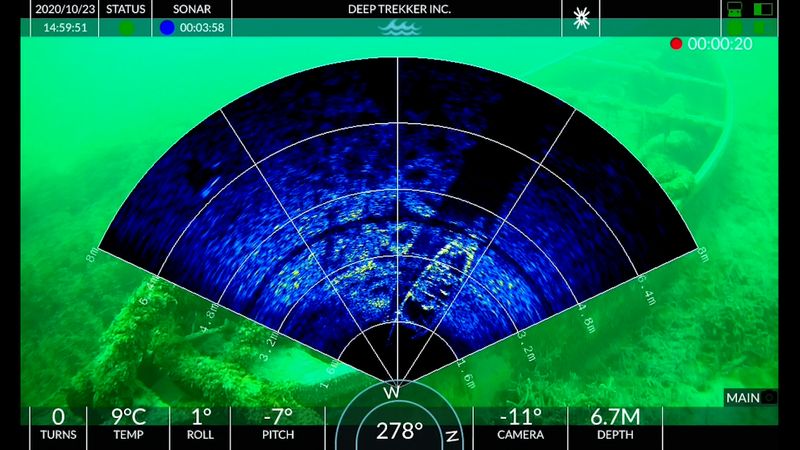
Sonar scan overlay with camera image in background.
This article was first published on
www.deeptrekker.comSearch and recovery missions are conducted by law enforcement, firefighters, first responders, and safety teams. These missions are quite dangerous for divers and time is critical. Traditionally, specially trained dive teams are employed to conduct searches. However, in recent years, many teams have been adopting new technological toolsets to improve costs, efficiency, and safety, such as the use of ROVs and sonar.
Remotely operated vehicles can be used to aid divers, monitor for safety, provide real-time visuals, and allow operators to deploy tailor-made tools such as sonar to navigate and locate targets through turbid waters. Search sites are often in treacherous waters, and the addition of an ROV can complement the marine unit to provide additional safety by monitoring of the divers and conducting preliminary searches to gain situational awareness of the environment.
What is Sonar?
Sound Navigation and Ranging (Sonar) technology is a system for the detection of objects underwater by means of sound waves sent out and reflected by those objects. Especially helpful for low visibility underwater operations when a camera system or diver would be unable to see clearly on their own, sonar is useful in a variety of applications.
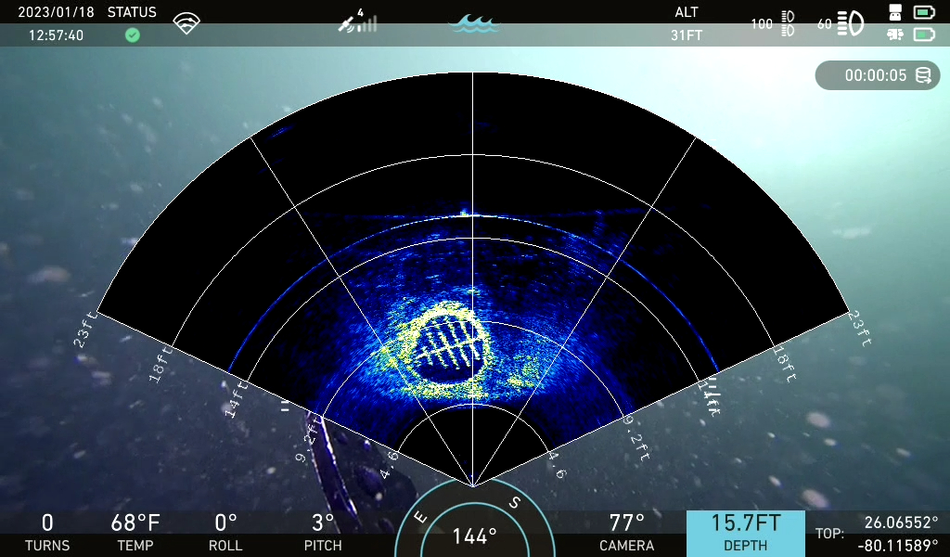
Sonar is advanced and specialized navigation technology primarily used in marine and aquatic industries and integrated into wide range of products for a variety of applications. It has been used effectively by operators in various industries and working environments. For example, sonar has the ability to help locate underwater objects in operations where turbid waters may hinder maximum camera visibility.
Sonar systems emit sound waves into the water, typically in the form of pulses, that travel through the water and interact with underwater objects. When the sound waves encounter an object, they bounce off its surface and return to the sonar system as echoes. By analyzing the characteristics of these echoes, such as their time of arrival, amplitude, and frequency, sonar systems can provide information about the distance, direction, size, shape, and composition of the objects in the water.
Why is Sonar Used?
Sonar is used for a range of applications, such as:
- Navigation and Mapping
- Object Detection and Targeting
- Fish Finding and Aquaculture
- Oceanographic Research
- Search and Recovery Operations
Sonar can be a cost-effective solution for many challenges, whether you need high resolution images in murky, low visibility water for salvage operations, collecting data on marine ecosystems and mapping the sea bed, or detecting underwater obstacles and objects of interest in search and recovery missions.
Sonar can help with many different tasks, including:
- Monitoring aquatic life, observing patterns, and studying characteristics of marine ecosystems and aquaculture fish farms
- Mapping the seabed, measuring depth or creating sea bottom characterization
- Making it easier to locate an ROV relative to target navigation
- Wide coverage searches that are much slower by traditional methods

Sonar has been used effectively by operators in various industries and working environments. Sonar technology has the ability to help locate underwater objects in deep salvage operations where turbid waters may hinder maximum camera visibility. It can also help locate underwater infrastructure for inspection and repair purposes. In underwater discovery, sonar can locate sunken ships in murky water or help researchers monitor aquatic life and environmental conditions. Perhaps most well known for search & recovery operations, sonar can help police and rescue teams locate evidence or victims underwater.
In summary, sonar is used to explore and understand the underwater world, providing valuable information for navigation, safety, scientific research, resource exploration, search and recovery, and various other applications.
How Does Sonar Aid Search and Recovery?
Sonar operates by sending out sound waves that reflect off objects, making it an invaluable tool for search and recovery operations, with a broad range of uses, such as:
- Providing assistance to divers and monitoring them for safety
- Accurate and effective navigation with 3D imaging and USBL positioning systems
- Producing detailed images even in low visibility water
- Providing an unobstructed view of the sea, river, or lake bed
- Searching for missing persons, missing evidence, sunken vehicles
Sonar allows teams to conduct searches and avoid elevated risks in these missions by providing aid to divers. Large search area are ineffective with traditional techniques, but with tools such as side scan sonar, these tasks become much more manageable, allowing for thorough searches of these large areas and local waterways quickly.
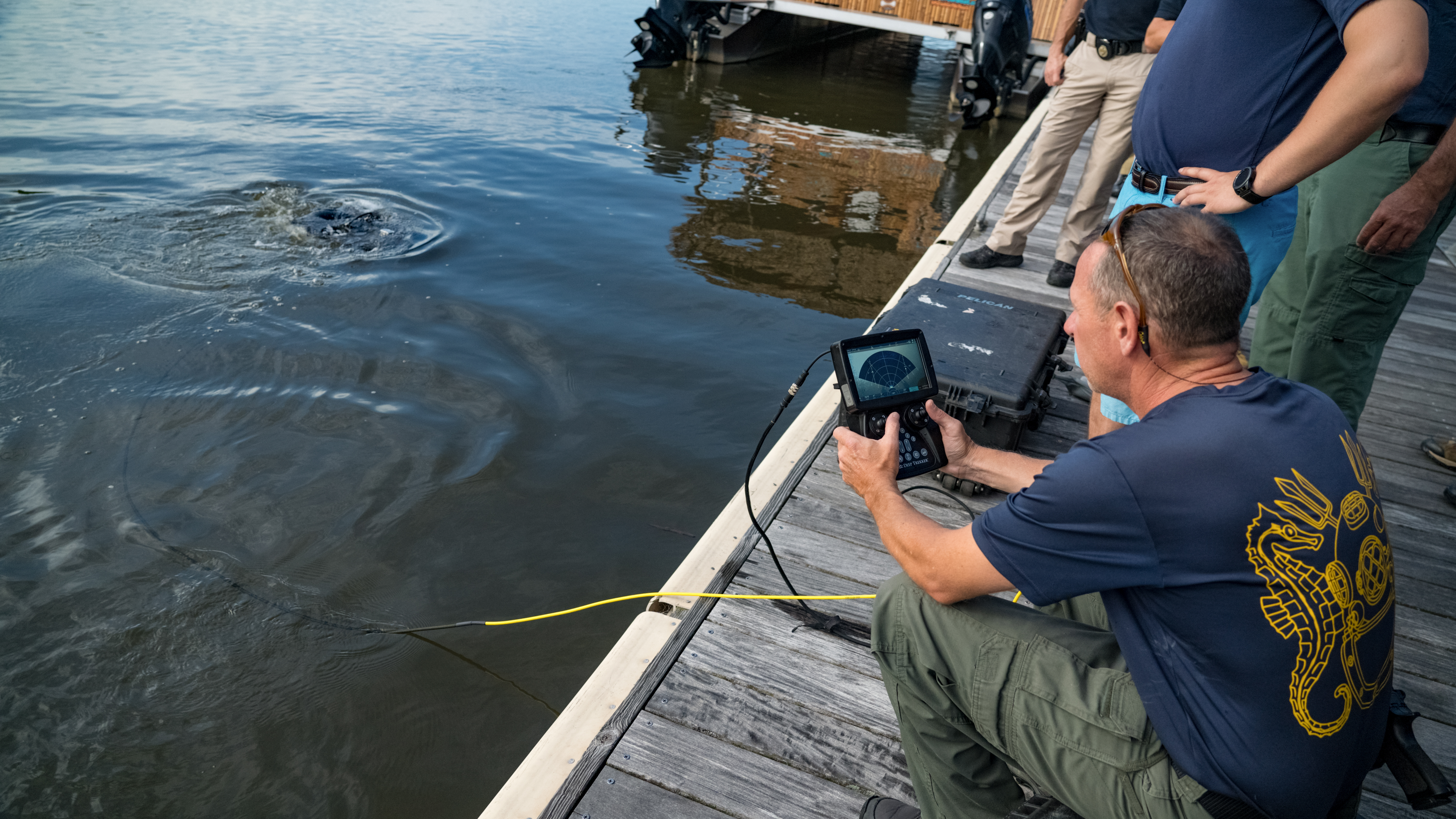
Using ROVs equipped with add-ons for sonar operations, such as USBL and DVL allows for accurate and effective navigation. Teams can plot their course and verify what areas have been previously searched for points of interest. Location tracking and breadcrumbing capabilities allow crews to record notes, photos and videos at waypoints for further analysis and record keeping. Furthermore, overlaid maps and station holding make real time positioning and navigation even easier for searching in large areas.
USBL Integration
Ultra-short baseline, or USBL uses triangulation to indicate the position on the ROV. Consisting of a transducer at the surface and a transponder on the ROV, USBL is the closest thing to underwater GPS as possible.
A relative position is plotted in a laptop generated software, this position can then be overlaid on maps such as Google Earth. Using a GPS coordinate from your computer or a device at the transducer, you can then estimate the GPS coordinate of the ROV within 20cm of accuracy.
As maps can be overlaid onto the software in real time, positioning and navigation is made even easier. Industries such as search & recovery use USBL systems to navigate large and potentially unfamiliar search areas. In short, having a USBL positioning system is extremely helpful for understanding where you are and where you are going under the water.
Side Scan Sonar
Side scan sonar comes in the form of a towfish or a side mounted sonar on a boat. While this option is not attached directly to an ROV, it is an important tool to discuss as it is often a common option for search and recovery operations.
With side scan sonar you can cover wide areas quickly and efficiently and its ability to generate detailed images of the seafloor and underwater objects makes it suitable for surveying large areas, conducting rapid search operations, and mapping extensive underwater regions.
ROVs can work well with a side scan sonar as well, particularly in terms of target identification. After a side scan sonar has swept an area, the ROV can be quickly deployed in seconds to safely identify points of interest and help divers reach their targets by following safely along the tether to the ROV.

Target Identification and Retrieval with Sonar
Working in turbid waters and low visibility environments makes the task of trying to detect, identify, and locate specific underwater objects or targets incredibly challenging. Using technology such as sonar provides operators with critical information about underwater targets that would otherwise be invisible to the human eye, allowing for effective decision making and planning for successful retrieval missions.
Using sonar data analysis, teams can identify targets and improve operational planning before sending human divers into the water, drastically improving the speed, accuracy, and safety of the mission.
Target Location
Before a successful recovery can be carried out, a search must be conducted to actually locate the target. Searches can be grueling and time consuming, with search areas often consisting of large areas and tough conditions.
The use of an ROV equipped with sonar provides recovery teams with a tool that allows them to safely and efficiently search large areas of water. Target location with sonar relies on the analysis of echo data and the integration of positioning information to determine the precise location of underwater targets.
Limerick Marine Search and Rescue Service, the first emergency response unit in Ireland using a state-of-the-art Deep Trekker underwater drone to assist in SAR operations, explains, “What the unit does is actually phenomenal, and because we deal mostly in zero visibility, the sonar facility on the drone is able to cast a shadow across the seabed and we can decipher on what we are looking at by breaking down elements of the shadow.”
Without the use of sonar and ROVs, teams typically send down divers to check an area section by section, which can be very slow, costly, dangerous, and not nearly as accurate or thorough as searches completed with the aid of sonar and ROVs.
These brave divers are often placed in potentially treacherous environments, putting their lives at risk with every dive. Water depth can also be a limiting factor as divers have maximum depths that they are able to dive and decompression can be required. Depending on the water temperature and other external factors, dive times may be seriously limited.
In the summer of 2019, Houston County Rescue was dispatched to recover the body of Kelsey Starling following a tragic boat crash. The search took place in Smith Lake, Alabama, a man-made reservoir with depths of up to 300 feet. Using their DTG3 and sonar, the team was able to locate Starling.
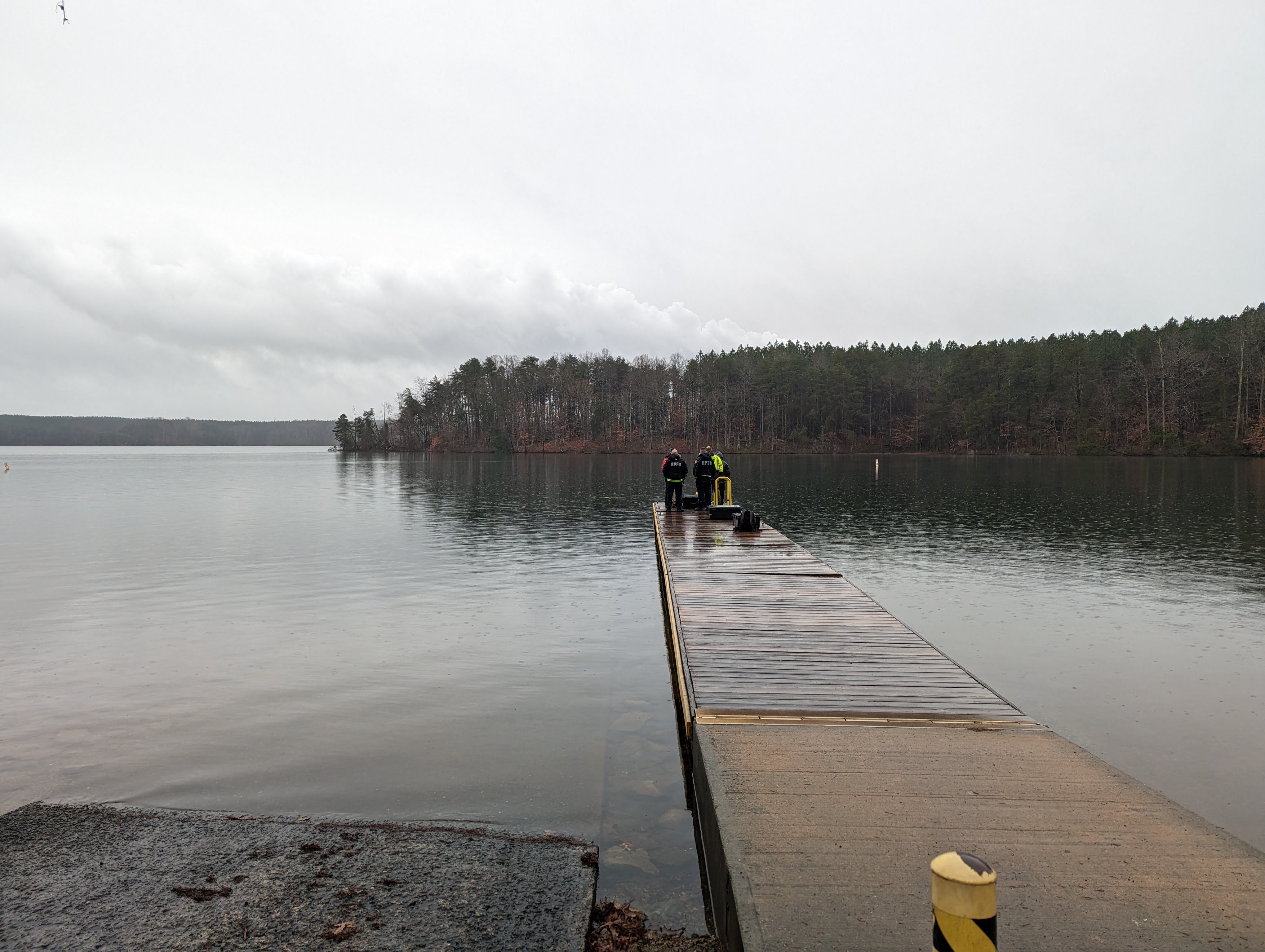
As the depths of the search area often exceeded 230 feet, divers would have had to spend nearly 3 hours decompressing for 45 minutes of searching. The DTG3 was able to dive all day to search, reducing risk and maximizing search time.
The use of a sonar equipped ROV is greatly beneficial in finding underwater targets in a much more safe, efficient, and effective manner than the typical traditional methods.
Target Identification
Once the target has been located in the search area with the help of sonar scans, the ROV can be used to identify these targets.
Lee County integrates the Deep Trekker Revolution ROV directly into their search and recovery procedures. After conducting witness interviews and testimonies to determine an appropriate area, the Lee County team uses sonar patterns on their boats to pick out targets underwater.
Rather than suiting up and sending divers down to confirm the targets, the team sends the ROV into the water to review the targets, which can be completed in a matter of minutes. Once the victim or evidence has been found, divers either follow the tether to the target or the Deep Trekker ROV is used to retrieve the evidence with a grabber claw, if possible.
“It’s not just our operations, it’s more of a regional asset for the state of North Carolina. It has sped up the process by which we find evidence, it’s increased the safety factor because we don't have to have divers in the water as much as before. Any time you can take and use something mechanical or electronic to make it safer for our responders, it’s definitely a big asset to what we’re trying to do,” shared Shane Seagroves, Emergency Services Director of Lee County Government.
With the use of a sonar-equipped ROV, targets can be identified quickly and safely to expedite the recovery process, and with speed being such an important process of these missions, this equipment is a game changer.
Target Retrieval
Sonar equipped ROVs are becoming more widely used in searches to work in tandem with divers for target retrieval. With the ability to provide real time visuals in low visibility environments, these tools are essential for search and recovery operations.
As outlined above,once a target of interest has been identified and located using sonar and an ROV, divers can use the ROV and tether as a guide to reach the target or the ROV can pull the target up on its own.
This use of the ROV has been demonstrated in numerous cases. Perhaps most notably is the case mentioned earlier of Kelsey Starling, who was recovered in Smith Lake, Alabama. Smith Lake is a man made reservoir with trees of up to 90 ft in height covering the bottom making recovery difficult.
After locating Starling, the team deliberately wrapped the DTG3 around the nearest tree to use as their diving guide line. Divers were then able to retrieve Starling quickly and safely by following the tether to their target. Ashton Davis, Houston County Rescue Chief and Board President noted that, “having the tether really helps recovery.”

Advantages of Integrating Sonar Systems with ROVs
Search and recovery missions are typically performed in very challenging and potentially dangerous environments. Integrating sonar systems with ROVs provides many advantages, such as:
- Precise maneuverability in difficult to reach or confined areas
- Real-time feedback
- Visual confirmation
- Improved navigation
- The ability to perform targeted recovery operations
This collaborative approach leverages the strengths of both technologies, enabling comprehensive and accurate underwater investigations. For example, ROVs integrated with side scan sonar can work incredibly well with target identification, making it much safer for the team to perform the recovery by removing a lot of the guess work involved with locating the target.
When working in areas such as murky water locations where it’s impossible to ascertain what is below the surface, ROVs that can maneuver in these spaces are invaluable. ROVs with attached sonar can reach a closer proximity to the target, which can be a huge advantage in getting higher resolution imagery, and a clearer picture of the underwater environment.
Operators can also receive real time feedback from the ROV sensors, helping them make adjustments to the sonar settings, such as beam orientation, frequency, or gain, or to optimize target detection and imaging. Being able to fine-tune sonar parameters based on real-time visual feedback can dramatically improve success rates and accuracy of the searches.
Using ROVs with sonar can also greatly improve navigation and positioning. By incorporating navigation sensors, pilots can track the location of the ROV in real time using ultra-short baseline (USBL) positioning systems, and maneuver with precision in difficult areas using doppler velocity log (DVL) stabilization and station holding, providing accurate position, heading, and depth information. This data can be utilized to enhance the georeferencing of sonar data, enabling precise mapping and target localization.

Ultimately, these types of missions can pose a serious threat to the safety of divers. ROVs with sonar make navigation in low visibility possible, can allow for searches in greater depths with more accuracy, and allow for a more efficient use of the search team’s time, which can be critical.
The benefits of pairing ROVs with sonar systems for search and rescue operations is clear. By using the sonar, either side scan sonar on a vessel or sonar directly on the ROV, you are able to quickly locate the objects or discrepancies underwater that may be the target you are searching for. From there, the ROV can be deployed to verify and retrieve, or aid in the retrieval of the object.
Deep Trekker ROVs for Search and Recovery
Deep Trekker ROVs have proven themselves as effective and useful tools for Search and Recovery & Public Safety teams, and are optimized for sonar operations. Specializing in identifying targets of interest, victim and evidence recovery, and rapid search response, a Deep Trekker ROV enhances and assists search and recovery teams.
When time is so critically important, the advantage of Deep Trekker ROVs getting eyes in the water in seconds can’t be understated. In time sensitive situations, the ROV provides real-time visuals quickly and safely. Tailor-made tools such as sonar, additional lighting, or grabber arms allow teams to quickly locate and retrieve victims or evidence.
A big advantage of Deep Trekker and BRIDGE technology is the ability to integrate imaging sonars and USBL Positioning system data via the handheld controller. The display shows this data and allows the pilot to record video, sensor data, sonar data and USBL data all as one. The USBL also allows for time stamped position data via a .csv file for easy interpretation after a dive. This eliminates the need for bulky setups with laptops and makes operations easier on the ROV pilot.
The easily transportable and deployable robots also allow teams to work effectively in remote and difficult locations. In an industry as potentially dangerous as search and recovery, the assistance provided by an ROV helps to keep divers safe.
Deep Trekker offers three submersible ROVs:
- DTG3
- PIVOT
- REVOLUTION
These vehicles are purpose built for versatility and customization, and engineered to meet a broad range of needs across many industries and verticals. In challenging search and recovery missions, they provide operators with a convenient and straightforward way to get eyes underwater. Equipped with sonar and a 4K camera, Deep Trekker’s ROVs deliver high quality underwater footage in nearly any environment.
The battery-operated robots are designed for ease of portability. Portability of an ROV is extremely important during a search and recovery mission. With bodies of water being located in some of the most remote locations on the planet, air transportation or on foot travel may be the only access. Deep Trekker vehicles come housed in their own convenient Pelican carrying cases, allowing them to be easily transported and deployed in isolated areas.
The DTG3 is a mini observation-class underwater ROV built to provide operators the ability to quickly deploy and visually inspect underwater environments within a matter of minutes. Battery operated with a depth rating of 200m (656ft), the DTG3 is versatile, durable, and extremely portable.
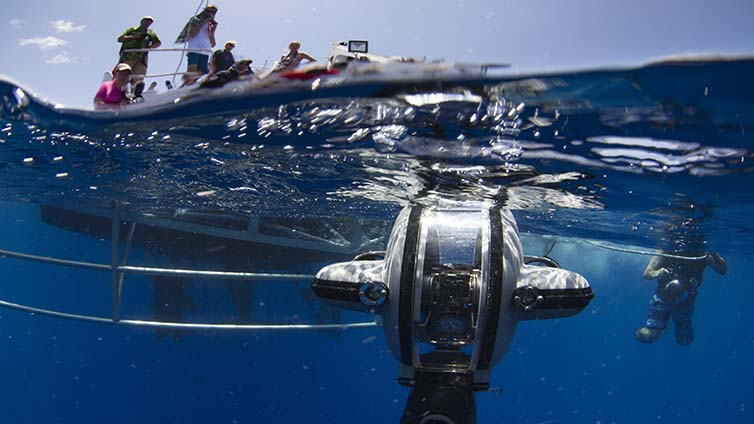
The PIVOT and REVOLUTION are completely re-imagined ROVs with six vectored thrusters for massively enhanced maneuverability and stability. The patented revolving head of the REVOLUTION allows operators to rotate the camera, manipulators, and sonar, all while station holding in moving water. Depth rated to 305m (1000ft) with field-swappable lithium-ion batteries, both the PIVOT and REVOLUTION are tough, portable, and adaptable.
Ashton Davis, Houston County Rescue Chief and Board President shared that, “By far the best piece of equipment other than divers is this ROV.”
If you need help finding the right technology for your missions, reach out to our robotics experts to find the right option for your applications and budget. We are happy to help. Get your custom quote today.